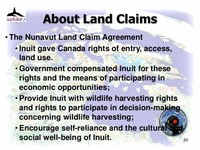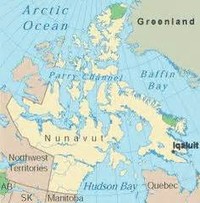Facts about Nunavut

The members of the unicameral Legislative Assembly of Nunavut are elected individually; there are no parties and the legislature is consensus-based.

The head of government, the premier of Nunavut, is elected by and from the members of the legislative assembly.

The mountains on the easternmost coasts of Nunavut are part of the Arctic Cordillera which stretches from northernmost Ellesmere Island to the northernmost tip of Labrador.

Canada's northernmost territory, Nunavut (“Noo-na-voot” in both English and French) means "our land" in Innuktitut, the language of Inuit.

Nunavut's head of state is a Commissioner appointed by the federal Minister of Indian Affairs and Northern Development.

Much of the food in Nunavut is imported, supplanted by what the Inuit fish, trap (small animals) and hunt (sea mammals).

Several islands in the area are divided between Nunavut and the Northwest Territories, notably Victoria, and Melville Islands.

Immigration brought new styles and instruments to Nunavut, including country music, bluegrass, square dancing, the button accordion, and the fiddle.

The highest point is Barbeau Peak on Ellesmere Island at a height of 8,583 feet (2616 m), which is also the highest point in Nunavut.

Virtually all of Nunavut's rivers drain into either the Hudson Bay or the Arctic Ocean.

Nunavut has land borders with the Northwest Territories on several islands as well as the mainland, and a tiny land border with Newfoundland and Labrador on Killiniq Island.

One of the most sparsely populated habitable regions on Earth (density 0.015/kmІ), Nunavut consists of small settlements which are clustered largely in the coastal areas.

Nunavut comprises two distinct physiographic regions: The Canadian Shield, including the mainland and the islands around Hudson Bay, and the Arctic Archipelago in the north.

The land claims agreement was decided in September 1992 and ratified by nearly 85 percent of the voters in Nunavut.

The creation of Nunavut resulted in the first major change to Canada's map since the incorporation of the new province of Newfoundland in 1949.

Grizzly bears, wolves, Arctic foxes, and red foxes are included in Nunavut's animal population, which also includes polar bears, walrus, and seals in its coastal areas.

Owing to Nunavut's vast size, the stated goal of the territorial government has been to decentralize governance beyond the region's capital.

Nunavut has four National Parks: Quttinirpaaq National Park on Ellesmere Island; Auyuittuq National Park on Baffin Island; Sirmilik National Park on northern Baffin Island and Bylot Island; and Ukkusiksalik National Park on the mainland.

The Canadian territory of Nunavut is a vast stretch of land which constitutes the greater part of the Canadian Arctic Archipelago, including its largest island, Baffin Island.

The creation of the Nunavut Territory from the Northwest Territories in 1999 is one part of the story of their struggle for recognition of their unique existence and the power to protect it.

Canada's 2006 Census recorded the population of Nunavut at 29,474, with 24,640 people identifying themselves as Inuit (83.6 percent of the total population).

Nunavut's unique culture and natural beauty attract tourists, and the service industry surrounding this, though small is significant.

The three dominant religions in Nunavut are Catholicism, Anglicanism, and Born again Christianity.

Nunavut's basic law lists four official languages: English, French, Inuktitut, and Inuinnaqtun, but to what degree Inuktitut and Inuinnaqtun can be thought of as separate languages is ambiguous in state policy.

Many traditional elements of the Inuit culture have been preserved in Nunavut, despite the impact of modern influences such as media and technology.

On July 9, 1993, the Nunavut Land Claims Agreement Act and the Nunavut Act were passed by the Canadian Parliament, with the transition completed on April 1, 1999.



